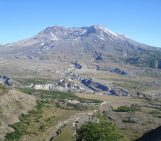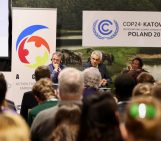Large volcanic eruptions have a significant impact on the Earth’s climate as aerosols (including sulphur dioxide and water vapour), together with ash are released into the atmosphere and increase the amount of sunlight reflected back into space (the albedo). This increase in reflectance (or decrease in energy absorption) can cause widespread climatic cooling, known as a ‘volcanic winter’.
However, recent research suggests that the impact of volcanism on climate may not be so clear cut. The Toba supereruption, which occurred some 74 thousand years ago, is one of the largest volcanic events that has occurred in the last 2 million years. Mount Toba, which lies in Sumatra, ejected approximately 2800 cubic kilometres of material when it erupted – that’s 280 times more than the 1980 eruption of Mount St Helens! Following the eruption, much of this spread throughout Asia and as far as East Africa, over 7000 kilometres from the volcano.

Artist’s impression of the Toba eruption (credit: Wikimedia Commons user Anyobody).
The last of the deposits from this eruption are known as the Youngest Toba Tuff (YTT). Tuff deposits are composed of ash and fragmented rock that are basted into the air during an explosive eruption. This material then falls to the ground to form a mixed deposit. The size of material in the deposit fines upwards and away from the source as the heavier material falls out first.
Curiously though, no tephra associated with this eruption has been found in Greenland or Antarctic ice cores. So to find a signature of the eruption here we need to use another method – sulphate records. When sulphur dioxide reaches the stratosphere, it combines with water to form sulphuric acid droplets. These reflect incoming solar radiation until they are precipitated out as snow or rain. In both Greenland and Antarctica, the amount of sulphate, or the acidity present within an ice core can be correlated with volcanic events.

Aerosol formation and its effect on albedo (credit: NASA).
Spikes in volcanic sulphate or acidity can be used as identify an eruption in the ice core record and annual layer counting between these spikes can be used to identify changes between volcanic events. The closely constrained records in Greenland and Antarctic allow us to take a closer look at how the eruption may have affected global climate – or alternatively, how it didn’t affect global climate.
Anders Svensson found the ice core records lent no support to the idea that a period of long-term global cooling was caused by Toba’s eruption. Why? Because Antarctica appeared to experience a major warming shortly after the event, meaning that the impact of the eruption on climate is likely to be much lower than we thought.

Lake Malawi (credit: NASA).
Another study, published earlier this year, showed that there was no significant dip in East African temperatures at the time of the eruption. After identifying tephra layers in sediment cores from Lake Malawi, geologists from the University of Oxford took a closer look at what the lake chemistry was like after the eruption. Lake Malawi is anoxic below 200 m due to strong temperature-induced water column stratification. Significant cooling would have caused the anoxic layer to overturn, completely altering the redox chemistry of the lake, but there was no evidence of this in their samples.
While these records, and those from the Greenland and Antarctic ice sheets, are not representative of the conditions closer to Toba, they show that the eruption’s impacts may not have been as widespread as previously thought, opening up the question of whether Toba, and other supereruptions are really as bad as we think.
By Sara Mynott, EGU Communications Officer
References:
Lane, C. S., Chorn, B. T. and Johnson, T. C.: Ash from the Toba supereruption in Lake Malawi shows no volcanic winter in East Africa at 75 ka. PNAS , 2013.
Svensson, A., Bigler, M., Blunier, T., Clausen, H. B. et al.: Direct linking of Greenland and Antarctic ice cores at the Toba eruption (74 kyr BP), Clim. Past, 9, 749–766, 2013.




